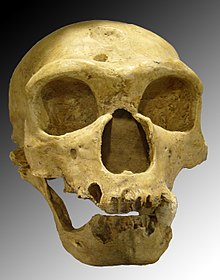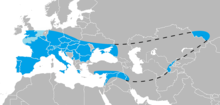Neanderthal
| Neanderthal Temporal range: Pleistocene
| |
|---|---|

| |
| H. neanderthalensis, La Chapelle-aux-Saints | |

| |
| Mounted Neanderthal skeleton, American Museum of Natural History | |
| Ipò ìdasí | |
| Ìṣètò onísáyẹ́nsì | |
| Ìjọba: | |
| Ará: | |
| Ẹgbẹ́: | |
| Ìtò: | |
| Ìdílé: | |
| Ìbátan: | |
| Irú: | H. neanderthalensis
|
| Ìfúnlórúkọ méjì | |
| Homo neanderthalensis King, 1864
| |

| |
| Range of Homo neanderthalensis. Eastern and northern ranges may be extended to include Okladnikov in Altai and Mamotnaia in Ural | |
| Synonyms | |
|
Palaeoanthropus neanderthalensis | |
Neanderthal (pípè /niːˈændərtɑːl/, /niːˈændərθɔːl/), tabi /neɪˈændərtɑːl/),[1] bakanna kiko bi Neandertal,[2] ni ikan ninu iran Homo to ti pare to wa nigba Pleistocene specimens ni Europe ati apaiwoorun ati arin Asia. Neanderthals je titopo boya bi subspecies (tabi eya) awon eniyan (Homo sapiens neanderthalensis) tabi bi iru eda otooto (Homo neanderthalensis).[3] Awon traits Neanderthal-asiwaju akoko yo wa ni Europe ni bi odun 600,000–350,000 seyin.[4] Loni (ni 2010) ifihan genetiki daba ibimopapo sele pelu Homo sapiens ni bi odun 80,000 to 50,000 seyin, won si ni gbagbo pe awon eniyan isun Eurasia je bi 1% de 4% Neanderthal.

|
Àyọkà yìí tàbí apá rẹ̀ únfẹ́ àtúnṣe sí. Ẹ le fẹ̀ jù báyìí lọ tàbí kí ẹ ṣàtúnṣe rẹ̀ lọ́nà tí yíò mu kúnrẹ́rẹ́. Ẹ ran Wikipedia lọ́wọ́ láti fẹ̀ẹ́ jù báyìí lọ. |
Itokasi
[àtúnṣe | àtúnṣe àmìọ̀rọ̀]- ↑ The pronunciation /niːˈændərθɔːl/ is very common in the United States and is often listed first in US dictionaries, for example American Heritage Dictionary and Random House Dictionaries. The UK pronunciation is /niːˈændərtɑːl/, as shown in Cambridge Advanced Learner's Dictionary)[Ìjápọ̀ tí kò ṣiṣẹ́ mọ́], and Oxford Advanced Learner's Dictionary.
- ↑ Neandertal is a widespread alternative spelling in English (see also US dictionaries in previous footnote) becoming so common that it is sometimes now listed first in dictionaries, for example MSN Encarta Archived 2009-12-26 at the Wayback Machine.. 2009-11-01.
- ↑ Tattersall I, Schwartz JH (June 1999). "Hominids and hybrids: the place of Neanderthals in human evolution". Proceedings of the National Academy of Sciences 96 (13): 7117–9. doi:10.1073/pnas.96.13.7117. PMC 33580. PMID 10377375. http://www.pnas.org/cgi/pmidlookup?view=long&pmid=10377375. Retrieved 17 May 2009.
- ↑ J. L. Bischoff et al. (2003). "The Sima de los Huesos Hominids Date to Beyond U/Th Equilibrium (>350 kyr) and Perhaps to 400–500 kyr: New Radiometric Dates". J. Archaeol. Sci. 30 (30): 275. doi:10.1006/jasc.2002.0834.
تلارملامتالاك نلاات
هت ه خت تت ت ت ت ت ت تت ةنتن
- All articles with dead external links
- Articles with dead external links from September 2023
- Articles with invalid date parameter in template
- Articles with permanently dead external links
- Webarchive template wayback links
- IUCN Red List extinct species
- Taxoboxes with the error color
- Taxobox articles missing a taxonbar
- Àwọn ọmọnìyàn

